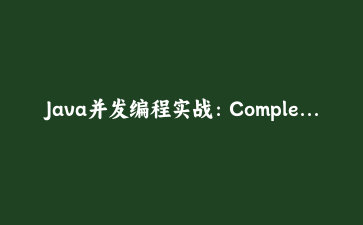原创作者:Java架构师 | 发布日期:2023年11月
一、异步编程的革命性变革
在现代高并发应用开发中,异步编程已成为提升系统性能的关键技术。Java 8引入的CompletableFuture彻底改变了传统的多线程编程模式,为开发者提供了更优雅、更强大的异步处理解决方案。
1.1 从Future到CompletableFuture的演进
// 传统的Future模式
ExecutorService executor = Executors.newFixedThreadPool(5);
Future future = executor.submit(() -> {
Thread.sleep(2000);
return "任务执行结果";
});
// 阻塞获取结果
String result = future.get(); // 这里会阻塞线程
// CompletableFuture的非阻塞模式
CompletableFuture completableFuture = CompletableFuture.supplyAsync(() -> {
try {
Thread.sleep(2000);
} catch (InterruptedException e) {
throw new IllegalStateException(e);
}
return "异步任务结果";
});
// 非阻塞回调处理
completableFuture.thenAccept(result -> System.out.println("接收到结果: " + result));二、CompletableFuture核心API实战
2.1 基础创建与执行方法
public class BasicCompletableFutureDemo {
// 模拟耗时服务调用
private String fetchUserData(String userId) {
try {
Thread.sleep(1000);
} catch (InterruptedException e) {
Thread.currentThread().interrupt();
}
return "用户数据-" + userId;
}
private Double calculateUserScore(String userId) {
try {
Thread.sleep(1500);
} catch (InterruptedException e) {
Thread.currentThread().interrupt();
}
return Math.random() * 100;
}
public void demonstrateBasicUsage() {
// 使用默认的ForkJoinPool执行异步任务
CompletableFuture userFuture = CompletableFuture.supplyAsync(() ->
fetchUserData("U1001"));
// 使用自定义线程池
ExecutorService customExecutor = Executors.newCachedThreadPool();
CompletableFuture scoreFuture = CompletableFuture.supplyAsync(() ->
calculateUserScore("U1001"), customExecutor);
// 组合两个异步任务
CompletableFuture combinedFuture = userFuture.thenCombine(scoreFuture,
(userData, score) -> String.format("用户数据: %s, 评分: %.2f", userData, score));
// 异步结果处理
combinedFuture.thenAcceptAsync(result ->
System.out.println("最终结果: " + result), customExecutor);
}
}2.2 电商订单处理系统实战案例
public class OrderProcessingSystem {
static class Order {
private String orderId;
private String userId;
private List productIds;
private double totalAmount;
// 构造方法和getter/setter
}
// 模拟外部服务调用
private CompletableFuture validateInventory(List productIds) {
return CompletableFuture.supplyAsync(() -> {
System.out.println("库存验证中... " + Thread.currentThread().getName());
try {
Thread.sleep(800);
} catch (InterruptedException e) {
Thread.currentThread().interrupt();
}
return productIds.size() < 10; // 模拟库存检查
});
}
private CompletableFuture calculateDiscount(String userId) {
return CompletableFuture.supplyAsync(() -> {
System.out.println("计算折扣中... " + Thread.currentThread().getName());
try {
Thread.sleep(600);
} catch (InterruptedException e) {
Thread.currentThread().interrupt();
}
return userId.startsWith("VIP") ? 0.1 : 0.0;
});
}
private CompletableFuture processPayment(Order order, double discount) {
return CompletableFuture.supplyAsync(() -> {
System.out.println("支付处理中... " + Thread.currentThread().getName());
try {
Thread.sleep(1200);
} catch (InterruptedException e) {
Thread.currentThread().interrupt();
}
double finalAmount = order.getTotalAmount() * (1 - discount);
return finalAmount > 0;
});
}
public CompletableFuture processOrder(Order order) {
return validateInventory(order.getProductIds())
.thenComposeAsync(inventoryValid -> {
if (!inventoryValid) {
return CompletableFuture.completedFuture("库存不足,订单处理失败");
}
return calculateDiscount(order.getUserId())
.thenComposeAsync(discount ->
processPayment(order, discount)
.thenApply(paymentSuccess ->
paymentSuccess ?
String.format("订单处理成功,折扣: %.0f%%", discount * 100) :
"支付失败,订单处理中止"
)
);
})
.exceptionally(throwable -> {
System.err.println("订单处理异常: " + throwable.getMessage());
return "系统异常,请稍后重试";
});
}
}三、高级组合与编排技术
3.1 多任务并行执行与结果聚合
public class AdvancedCompositionDemo {
// 模拟多个微服务调用
private CompletableFuture getUserProfile(String userId) {
return CompletableFuture.supplyAsync(() -> {
sleep(1000);
return "用户档案-" + userId;
});
}
private CompletableFuture<List> getUserOrders(String userId) {
return CompletableFuture.supplyAsync(() -> {
sleep(1200);
return Arrays.asList("订单1", "订单2", "订单3");
});
}
private CompletableFuture<Map> getUserPreferences(String userId) {
return CompletableFuture.supplyAsync(() -> {
sleep(800);
Map prefs = new HashMap();
prefs.put("theme", "dark");
prefs.put("language", "zh-CN");
return prefs;
});
}
public CompletableFuture buildUserDashboard(String userId) {
CompletableFuture profileFuture = getUserProfile(userId);
CompletableFuture<List> ordersFuture = getUserOrders(userId);
CompletableFuture<Map> prefsFuture = getUserPreferences(userId);
// 使用allOf等待所有任务完成
return CompletableFuture.allOf(profileFuture, ordersFuture, prefsFuture)
.thenApplyAsync(v -> {
try {
String profile = profileFuture.get();
List orders = ordersFuture.get();
Map preferences = prefsFuture.get();
return new UserDashboard(profile, orders, preferences);
} catch (Exception e) {
throw new CompletionException(e);
}
});
}
static class UserDashboard {
private final String userProfile;
private final List orders;
private final Map preferences;
// 构造方法和getter
}
private void sleep(long millis) {
try {
Thread.sleep(millis);
} catch (InterruptedException e) {
Thread.currentThread().interrupt();
}
}
}3.2 超时控制与错误恢复机制
public class TimeoutAndRecoveryDemo {
public CompletableFuture fetchDataWithTimeout(String url, long timeout, TimeUnit unit) {
CompletableFuture dataFuture = CompletableFuture.supplyAsync(() -> {
// 模拟网络请求
sleep(2000);
return "从 " + url + " 获取的数据";
});
CompletableFuture timeoutFuture = CompletableFuture.supplyAsync(() -> {
try {
unit.sleep(timeout);
} catch (InterruptedException e) {
Thread.currentThread().interrupt();
}
return "超时默认数据";
});
// 任何一个完成就返回
return dataFuture.applyToEither(timeoutFuture, Function.identity())
.exceptionally(throwable -> "错误恢复数据");
}
public CompletableFuture resilientServiceCall() {
List fallbackUrls = Arrays.asList(
"https://primary.service.com",
"https://backup1.service.com",
"https://backup2.service.com"
);
// 依次尝试多个服务端点
CompletableFuture result = CompletableFuture.completedFuture("初始值");
for (String url : fallbackUrls) {
result = result.thenCompose(prevResult -> {
if (!prevResult.equals("初始值")) {
return CompletableFuture.completedFuture(prevResult);
}
return fetchDataFromService(url)
.exceptionally(throwable -> "初始值"); // 失败时继续尝试下一个
});
}
return result.thenApply(finalResult ->
finalResult.equals("初始值") ? "所有服务都不可用" : finalResult);
}
private CompletableFuture fetchDataFromService(String url) {
return CompletableFuture.supplyAsync(() -> {
if (Math.random() > 0.3) { // 模拟服务失败
throw new RuntimeException("服务调用失败: " + url);
}
return "成功数据来自: " + url;
});
}
}四、性能优化与最佳实践
4.1 线程池配置策略
public class ThreadPoolConfiguration {
// CPU密集型任务线程池
public ExecutorService createCpuIntensivePool() {
int corePoolSize = Runtime.getRuntime().availableProcessors();
return new ThreadPoolExecutor(
corePoolSize,
corePoolSize * 2,
60L, TimeUnit.SECONDS,
new LinkedBlockingQueue(1000),
new ThreadPoolExecutor.CallerRunsPolicy()
);
}
// IO密集型任务线程池
public ExecutorService createIoIntensivePool() {
return new ThreadPoolExecutor(
10,
50,
60L, TimeUnit.SECONDS,
new SynchronousQueue(),
new ThreadPoolExecutor.CallerRunsPolicy()
);
}
public void demonstrateOptimalUsage() {
ExecutorService cpuPool = createCpuIntensivePool();
ExecutorService ioPool = createIoIntensivePool();
// CPU密集型任务使用专用线程池
CompletableFuture.supplyAsync(() -> {
// 复杂计算任务
return heavyComputation();
}, cpuPool);
// IO密集型任务使用专用线程池
CompletableFuture.supplyAsync(() -> {
// 网络请求或数据库操作
return networkCall();
}, ioPool);
}
}4.2 监控与调试技巧
public class CompletableFutureMonitor {
public static CompletableFuture withMonitoring(
CompletableFuture future, String taskName) {
long startTime = System.currentTimeMillis();
return future
.whenComplete((result, throwable) -> {
long duration = System.currentTimeMillis() - startTime;
if (throwable != null) {
System.out.printf("任务 %s 执行失败,耗时: %dms, 异常: %s%n",
taskName, duration, throwable.getMessage());
} else {
System.out.printf("任务 %s 执行成功,耗时: %dms%n",
taskName, duration);
}
});
}
// 使用示例
public void monitoredExecution() {
CompletableFuture future = CompletableFuture.supplyAsync(() -> {
sleep(1000);
return "监控任务结果";
});
withMonitoring(future, "数据获取任务")
.thenAccept(result -> System.out.println("处理结果: " + result));
}
}五、实际项目应用场景
5.1 微服务架构中的异步调用
public class MicroserviceOrchestrator {
public CompletableFuture createOrder(OrderRequest request) {
// 并行执行验证步骤
CompletableFuture inventoryCheck = checkInventory(request);
CompletableFuture userValidation = validateUser(request.getUserId());
CompletableFuture priceCalculation = calculateFinalPrice(request);
return CompletableFuture.allOf(inventoryCheck, userValidation, priceCalculation)
.thenCompose(v -> {
try {
if (!inventoryCheck.get() || !userValidation.get()) {
return CompletableFuture.completedFuture(
OrderResponse.failure("验证失败"));
}
double finalPrice = priceCalculation.get();
return processPayment(request, finalPrice)
.thenCompose(paymentId ->
updateInventory(request)
.thenApply(inventoryUpdate ->
OrderResponse.success(paymentId, finalPrice)
)
);
} catch (Exception e) {
return CompletableFuture.failedFuture(e);
}
});
}
}5.2 批量数据处理流水线
public class DataProcessingPipeline {
public CompletableFuture processDataBatch(List dataBatch) {
// 创建并行处理流水线
List<CompletableFuture> processingFutures = dataBatch.stream()
.map(data -> CompletableFuture
.supplyAsync(() -> validateData(data))
.thenApplyAsync(validated -> transformData(validated))
.thenAcceptAsync(transformed -> storeData(transformed))
.exceptionally(throwable -> {
logError(throwable);
return null;
})
)
.collect(Collectors.toList());
// 等待所有数据处理完成
return CompletableFuture.allOf(
processingFutures.toArray(new CompletableFuture[0])
);
}
}六、总结与进阶方向
CompletableFuture为Java异步编程带来了革命性的改进,通过本指南的学习,你应该掌握:
- CompletableFuture的核心概念和创建方式
- 复杂的任务组合与编排技术
- 超时控制、错误恢复等容错机制
- 性能优化的线程池配置策略
- 在实际项目中的典型应用场景
进阶学习建议:深入理解Project Loom的虚拟线程、响应式编程框架如Reactor、以及Java 19中的结构化并发等前沿技术,持续提升高并发系统架构能力。





